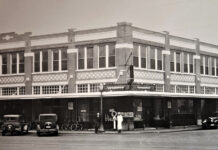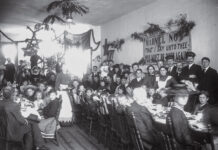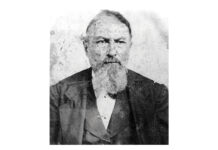
Photo courtesy Norman A. Nicolson Collection, Historic Mobile Preservation Society
The black and white snapshot below shows the remains of Fort Tracy, a Confederate fortification established in 1864 during the Civil War. Also known as Battery Tracy, the fort was located on the west bank of the Blakeley River about three miles above Spanish Fort, another Confederate post. Fort Tracy’s purpose was to block Union gunboats from getting up river above Spanish Fort. After engaging in the battle for Fort Blakeley and Spanish Fort, in which both forts fell, Fort Tracy’s role became obselete. It was evacuated and then blown up on April 11, 1865. However, some debris remained on the Apalachee River near the Blakeley River. The below photograph, taken in 1957 during a low tide, depicts an inner and outer semicircle of timber pilings seen up close on the river bank.
The timeline of Fort Tracy and the Battle of Spanish Fort aftermath
From its initial establishment to its evacuation and destruction, here are a few significant dates in Fort Tracy’s history and the Mobile Bay area during the Civil War.
1863: Fort Tracy, then called Apalachee Battery, is built by Army engineer Danville Leadbetter. The fort was supported by shore batteries on the east bank of the Blakeley River and Fort Huger at the intersection of the Blakeley River and the Apalachee River.
May 1863: Apalachee Battery is renamed to Battery Tracy, or Fort Tracy, in honor of Brigadier General Edward D. Tracy, an Alabamian killed at Port Gibson, Mississippi. Many forts and batteries across the Mobile area were renamed at this time to honor fallen Southern soldiers.
March 27 – April 8, 1865: The Battle of Spanish Fort is fought. The Union forces made their move, came under fire and surrounded the land approaches to Spanish Fort about a half mile from the Confederate lines by sunset on the first day of the battle.
April 8, 1865: Spanish Fort is officially captured by Union forces. The day after this, the Civil War effectively ended when Confederate General Robert E. Lee surrendered his troops to Union General Ulysses S. Grant at Appomattox Court House in Virginia.
April 10, 1865: The Union troops begin bombarding Forts Tracy and Huger, the last remaining forts of any real consequence at the time that were still garrisoned by the Confederates.
April 11, 1865: On the orders of Major General Dabney H. Maury, Confederate commander of the Mobile garrison, the Confederate troops leave Fort Tracy, blowing it up upon their departure.
April 12, 1865: Robert H. Slough, the mayor of Mobile. surrenders the city to Union military forces without a fight. It was the last major Confederate port to be captured by Union forces in the Civil War.
By the Numbers
10,000
The number of troops Mobile’s garrison had by earlya 1865. They were led by Confederate commander Major General Dabney H. Maury.
1,401
The number of estimated casualties resulting from the Battle of Spanish Fort. Of those killed during the long battle in Baldwin County, 657 were Union soldiers and 744 were Confederate soldiers.
4,500
The amount of soldiers that Gen. Maury escaped with after the seige on Forts Tracy and Huger. They escaped with 27 guns toward Meridian, Mississippi, where Maury hoped to regroup.
1,000 yards
The approximate distance between Fort Tracy and Fort Huger. They were both part of the Mobile defenses at Spanish Fort. Fort Huger was an earthwork fortification with four bastions facing down the river and open to the north.
Do you know any further details about this photo? Let us know! Email [email protected].





